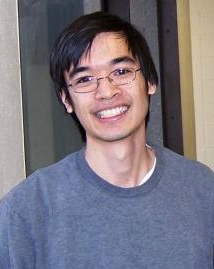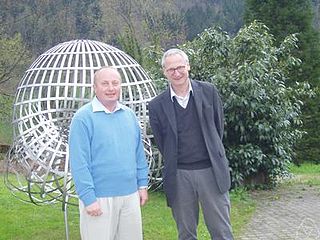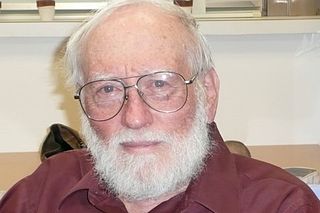Related Research Articles
Combinatorics is an area of mathematics primarily concerned with counting, both as a means and an end in obtaining results, and certain properties of finite structures. It is closely related to many other areas of mathematics and has many applications ranging from logic to statistical physics, from evolutionary biology to computer science, etc.

Mathematics includes the study of such topics as quantity, structure (algebra), space (geometry), and change. It has no generally accepted definition.
Mathematical logic is a subfield of mathematics exploring the applications of formal logic to mathematics. It bears close connections to metamathematics, the foundations of mathematics, and theoretical computer science. The unifying themes in mathematical logic include the study of the expressive power of formal systems and the deductive power of formal proof systems.

Nicolas Bourbaki is the collective pseudonym of a group of mathematicians, predominantly French alumni of the École normale supérieure (ENS). Founded in 1934–1935, the Bourbaki group originally intended to prepare a new textbook in analysis. Over time the project became much more ambitious, growing into a large series of textbooks published under the Bourbaki name, meant to treat modern pure mathematics. The series is known collectively as the Éléments de mathématique, the group's central work. Topics treated in the series include set theory, abstract algebra, topology, analysis, Lie groups and Lie algebras.

Raoul Bott was a Hungarian-American mathematician known for numerous basic contributions to geometry in its broad sense. He is best known for his Bott periodicity theorem, the Morse–Bott functions which he used in this context, and the Borel–Bott–Weil theorem.

Israel Moiseevich Gelfand, also written Israïl Moyseyovich Gel'fand, or Izrail M. Gelfand was a prominent Soviet mathematician. He made significant contributions to many branches of mathematics, including group theory, representation theory and functional analysis. The recipient of many awards, including the Order of Lenin and the first Wolf Prize, he was a Foreign Fellow of the Royal Society and professor at Moscow State University and, after immigrating to the United States shortly before his 76th birthday, at Rutgers University. Gelfand is also a 1994 MacArthur Fellow.

Ilya Piatetski-Shapiro was a Soviet-born Israeli mathematician. During a career that spanned 60 years he made major contributions to applied science as well as pure mathematics. In his last forty years his research focused on pure mathematics; in particular, analytic number theory, group representations and algebraic geometry. His main contribution and impact was in the area of automorphic forms and L-functions.

Terence Chi-Shen Tao is an Australian-American mathematician. He is a professor of mathematics at the University of California, Los Angeles (UCLA), where he holds the James and Carol Collins chair. His research includes topics in harmonic analysis, partial differential equations, algebraic combinatorics, arithmetic combinatorics, geometric combinatorics, probability theory, compressed sensing and analytic number theory.

Arnold Ephraim Ross was a mathematician and educator who founded the Ross Mathematics Program, a number theory summer program for gifted high school students. He was born in Chicago, but spent his youth in Odessa, Ukraine, where he studied with Samuil Shatunovsky. Ross returned to Chicago and enrolled in University of Chicago graduate coursework under E. H. Moore, despite his lack of formal academic training. He received his Ph.D. and married his wife, Bee, in 1931.

Jean-Louis Verdier was a French mathematician who worked, under the guidance of his doctoral advisor Alexander Grothendieck, on derived categories and Verdier duality. He was a close collaborator of Grothendieck, notably contributing to SGA 4 his theory of hypercovers and anticipating the later development of étale homotopy by Michael Artin and Barry Mazur, following a suggestion he attributed to Pierre Cartier. Saul Lubkin's related theory of rigid hypercovers was later taken up by Eric Friedlander in his definition of the étale topological type.
John Francis Riordan was an American mathematician and the author of major early works in combinatorics, particularly Introduction to Combinatorial Analysis and Combinatorial Identities.
In mathematics and social science, a collaboration graph is a graph modeling some social network where the vertices represent participants of that network and where two distinct participants are joined by an edge whenever there is a collaborative relationship between them of a particular kind. Collaboration graphs are used to measure the closeness of collaborative relationships between the participants of the network.

Rostislav Ivanovich Grigorchuk is a Soviet and Russian mathematician working in the area of group theory. He holds the rank of Distinguished Professor in the Mathematics Department of Texas A&M University. Grigorchuk is particularly well known for having constructed, in a 1984 paper, the first example of a finitely generated group of intermediate growth, thus answering an important problem posed by John Milnor in 1968. This group is now known as the Grigorchuk group and it is one of the important objects studied in geometric group theory, particularly in the study of branch groups, automata groups and iterated monodromy groups.
Algebra is one of the broad parts of mathematics, together with number theory, geometry and analysis. In its most general form, algebra is the study of mathematical symbols and the rules for manipulating these symbols; it is a unifying thread of almost all of mathematics. It includes everything from elementary equation solving to the study of abstractions such as groups, rings, and fields. The more basic parts of algebra are called elementary algebra; the more abstract parts are called abstract algebra or modern algebra. Elementary algebra is generally considered to be essential for any study of mathematics, science, or engineering, as well as such applications as medicine and economics. Abstract algebra is a major area in advanced mathematics, studied primarily by professional mathematicians.
Qaiser Mushtaq, , is a Pakistani mathematician and academic who has made numerous contributions in the field of Group theory and Semigroup. He has been vice-chancellor of The Islamia University Bahawalpur from December 2014 to December 2018. Mushtaq is one of the leading mathematicians and educationists in Pakistan. Through his research and writings, he has exercised a profound influence on mathematics in Pakistan. Mushtaq is an honorary full professor at the Mathematics Division of the Institute for Basic Research, Florida, US.
Derek Gordon Corneil is a Canadian mathematician and computer scientist, a professor emeritus of computer science at the University of Toronto, and an expert in graph algorithms and graph theory.

Elliott Ward Cheney Jr. was an American mathematician and an Emeritus Professor at the University of Texas at Austin. Known to his friends and colleagues as Ward Cheney, he was one of the pioneers in the fields of approximation theory and numerical analysis. His 1966 book, An Introduction to Approximation Theory, remains in print and is "highly respected and well known", "a small book almost encyclopedic in character", and "is a classic with few competitors".
A Riordan array is an infinite lower triangular matrix, , constructed out of two formal power series, and , in such a way that . A Riordan array is an element of the Riordan group. It was created by mathematician Louis W. Shapiro.

Howard Alan Masur is an American mathematician who works on topology, geometry and combinatorial group theory.

Stephen James Rallis was an American mathematician who worked on group representations, automorphic forms, the Siegel–Weil formula, and Langlands L-functions.
References
- ↑ "Shapiro, Louis W." Virtual International Authority File.
- ↑ "People | Howard University Department of Mathematics". mathematics.howard.edu.
- ↑ "Louis Welles Shapiro". Math Genealogy Project.
- ↑ Louis W. Shapiro, Seyoum Getu, Wen-Jin Woan, Leon C. Woodson, The Riordan group, Discrete Applied Mathematics, Volume 34, Issues 1–3, 1991, pages 229–239, ISSN 0166-218X, https://doi.org/10.1016/0166-218X(91)90088-E.
- ↑ "6th International Conference on Riordan Arrays and Related Topics". 6th International Conference on Riordan Arrays and Related Topics.
- ↑ "5th International Conference on Riordan Arrays and Related Topics". 5th International Conference on Riordan Arrays and Related Topics.
| This article about an American mathematician is a stub. You can help Wikipedia by expanding it. |